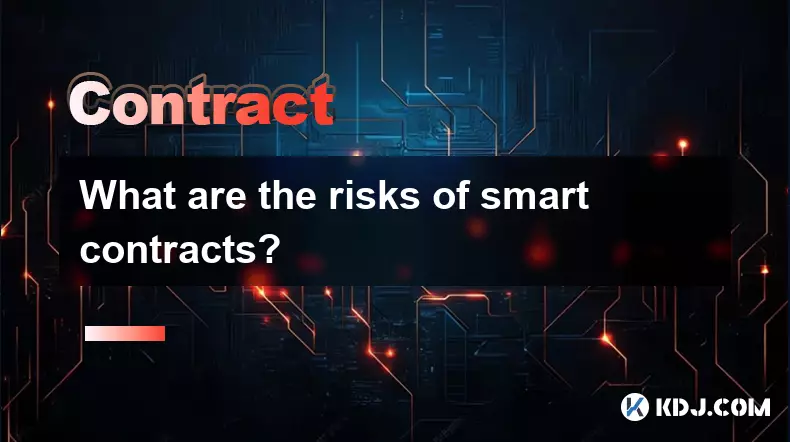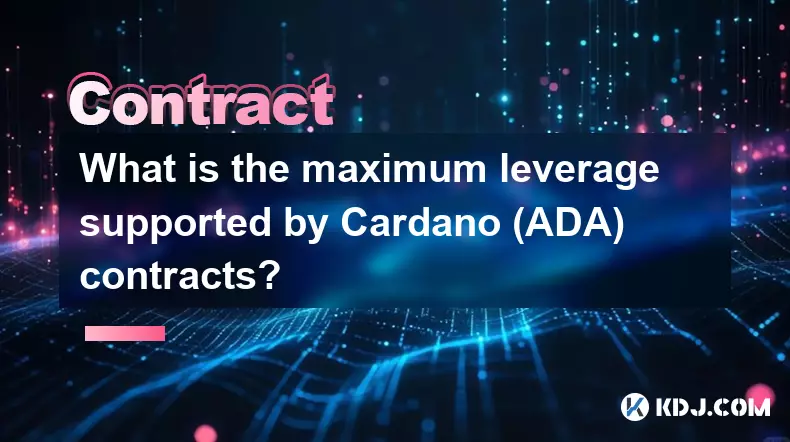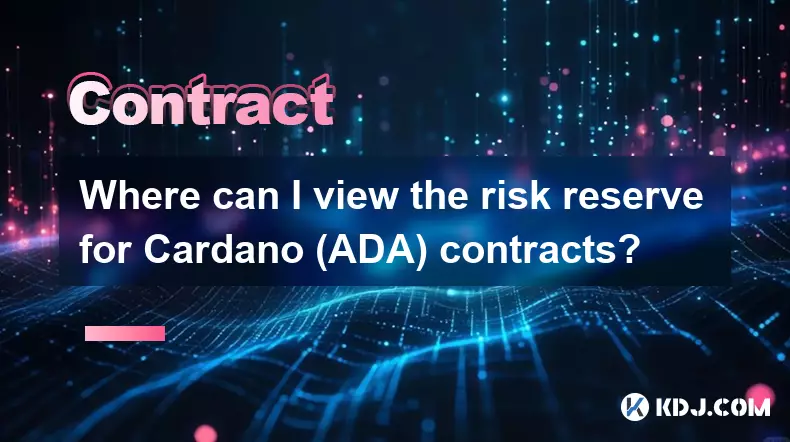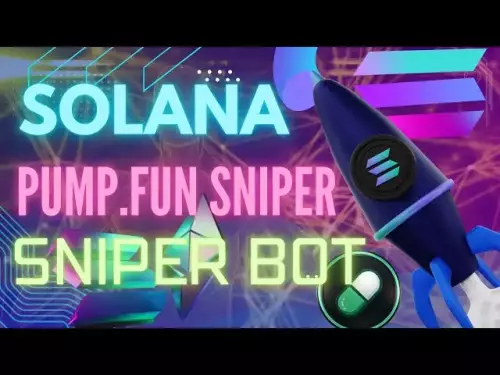-
 bitcoin
bitcoin $112195.049338 USD
2.42% -
 ethereum
ethereum $4124.915858 USD
2.81% -
 tether
tether $1.000570 USD
0.02% -
 xrp
xrp $2.861568 USD
2.25% -
 bnb
bnb $1000.346670 USD
3.04% -
 solana
solana $209.070819 USD
3.38% -
 usd-coin
usd-coin $0.999870 USD
0.02% -
 dogecoin
dogecoin $0.235379 USD
2.65% -
 tron
tron $0.335681 USD
-0.20% -
 cardano
cardano $0.803501 USD
3.38% -
 hyperliquid
hyperliquid $47.120881 USD
3.56% -
 chainlink
chainlink $21.501300 USD
3.44% -
 ethena-usde
ethena-usde $1.000571 USD
0.02% -
 avalanche
avalanche $29.793378 USD
3.62% -
 stellar
stellar $0.366964 USD
2.42%
What are the risks of smart contracts?
Smart contract vulnerabilities, third-party risks, and poor economic design can lead to massive financial losses, as seen in the $60M DAO hack and numerous DeFi exploits.
Sep 16, 2025 at 02:55 am

Risks Associated with Smart Contract Vulnerabilities
1. Smart contracts are self-executing agreements written in code, deployed on blockchain networks like Ethereum. While they offer automation and transparency, flaws in their programming can lead to irreversible consequences. A single coding error, such as improper input validation or incorrect logic flow, may allow attackers to exploit the contract and drain funds.
2. One of the most notorious examples is the DAO hack in 2016, where a recursive call vulnerability enabled an attacker to withdraw over $60 million worth of Ether. This incident highlighted how even well-funded and widely reviewed projects can contain critical bugs that compromise security.
3. Because blockchains are immutable, once a smart contract is deployed, it cannot be altered unless built with upgradeability features. This immutability means that any vulnerability discovered post-deployment remains exploitable unless mitigated through external interventions like hard forks.
4. Many developers lack formal training in secure coding practices specific to blockchain environments. As a result, common programming mistakes—such as reentrancy, integer overflow, and unchecked external calls—are frequently repeated across new projects.
5. The absence of standardized auditing protocols increases the likelihood of undetected vulnerabilities persisting in live contracts, exposing users and investors to significant financial risk.
Third-Party Dependencies and Supply Chain Risks
1. Modern smart contracts often rely on external libraries, oracles, and other smart contracts to function. These dependencies expand the attack surface, as a compromise in any linked component can affect the entire system.
2. Oracles, which provide real-world data to smart contracts, represent a major point of failure. If an oracle is manipulated or feeds incorrect information, the contract may execute based on false inputs—a scenario known as an 'oracle attack.'
3. Open-source components used in development may contain hidden backdoors or outdated functions with known exploits. Projects that fail to verify the integrity and maintenance status of these tools expose themselves to supply chain attacks.
4. Some decentralized finance (DeFi) platforms integrate multiple third-party protocols to enhance functionality. However, if one integrated protocol suffers a breach, the ripple effect can trigger cascading failures across interconnected systems.
5. Lack of due diligence in vetting external services significantly amplifies systemic risk within the ecosystem, especially when high-value transactions depend on unverified sources.
Economic and Governance Exploits
1. Beyond technical flaws, smart contracts can be exploited through economic design weaknesses. For instance, incentive structures that reward certain behaviors may be gamed by sophisticated actors who manipulate market conditions for profit.
2. Flash loan attacks exemplify this category, where attackers borrow large sums without collateral, manipulate asset prices on decentralized exchanges, and repay the loan—all within a single transaction. These attacks exploit the very mechanisms intended to increase liquidity and efficiency.
3. Governance tokens give holders voting power over protocol changes, but concentrated ownership allows whales to push through decisions that benefit themselves at the expense of smaller participants.
4. Some contracts implement time-locked upgrades or emergency pause functions controlled by centralized multisig wallets. If these keys are compromised or misused, governance becomes a vector for insider threats or coercion.
5. Poorly designed incentive models and centralized control points undermine decentralization principles and open the door to coordinated exploitation.
Frequently Asked Questions
How can developers prevent reentrancy attacks in smart contracts?Reentrancy attacks occur when a malicious contract repeatedly calls back into a vulnerable function before the initial execution completes. Developers can mitigate this by using the 'checks-effects-interactions' pattern, ensuring state changes happen before external calls. Additionally, applying non-reentrant modifiers and conducting thorough testing with tools like MythX or Slither helps identify potential issues.
What role do audits play in securing smart contracts?Audits involve systematic reviews of smart contract code by security experts to detect vulnerabilities before deployment. Reputable audit firms analyze logic flows, test edge cases, and assess compliance with best practices. While audits reduce risk, they do not guarantee immunity from exploits, especially if new attack vectors emerge after review.
Can smart contracts be updated after deployment?Most smart contracts are immutable once deployed, meaning their code cannot change. However, some use proxy patterns or upgradeable architectures that separate logic from storage. These designs allow developers to deploy new versions of the logic contract while preserving user data, though they introduce complexity and potential security trade-offs.
Why are flash loans dangerous for DeFi protocols?Flash loans enable borrowers to take out uncollateralized loans under the condition they are repaid within the same transaction. Attackers leverage these loans to artificially inflate or deflate token prices on decentralized exchanges, tricking smart contracts into making incorrect valuations. This manipulation facilitates theft from lending pools or price oracles.
Disclaimer:info@kdj.com
The information provided is not trading advice. kdj.com does not assume any responsibility for any investments made based on the information provided in this article. Cryptocurrencies are highly volatile and it is highly recommended that you invest with caution after thorough research!
If you believe that the content used on this website infringes your copyright, please contact us immediately (info@kdj.com) and we will delete it promptly.
- Citi's Token Services: Clearing the Path for 24/7 Global Payments
- 2025-09-30 04:45:16
- ADA, Mutuum Finance, and Cardano Pattern: Navigating Crypto Opportunities Like a New Yorker
- 2025-09-30 04:45:16
- Bitcoin, XRP, and 250x Gains: Is MAGACOIN FINANCE the Next Big Thing?
- 2025-09-30 04:50:01
- Heada, Shiba inu, and Blockddddddded Faucet: A Crypto Trifecta
- 2025-09-30 05:05:11
- Citi's Token Services and 24/7 USD Clearing: A New Era for Global Payments
- 2025-09-30 04:50:01
- Uniswap (UNI) Price Check: Navigating Channel Targets and Market Sentiment
- 2025-09-30 05:05:11
Related knowledge

What is the maximum leverage supported by Cardano (ADA) contracts?
Sep 30,2025 at 03:37am
Understanding Leverage in ADA Derivatives Trading1. Leverage in cryptocurrency futures and perpetual contracts allows traders to control larger positi...

How do I use the scheduled order feature in Cardano (ADA) contracts?
Sep 28,2025 at 10:18pm
Understanding Scheduled Orders in Cardano Smart ContractsCardano operates on a proof-of-stakes consensus mechanism and uses the Plutus scripting langu...

Where can I view the risk reserve for Cardano (ADA) contracts?
Sep 29,2025 at 09:19pm
Risk Reserve Overview in Cardano (ADA) Ecosystem1. The concept of a risk reserve within the Cardano blockchain does not align with traditional central...

How do I enable the "scalping-only" mode for Cardano (ADA) contracts?
Sep 24,2025 at 03:19am
Understanding Scalping Strategies in Crypto Derivatives1. Scalping in cryptocurrency trading refers to executing multiple short-term trades within min...

What is the settlement time for Cardano (ADA) contracts?
Sep 28,2025 at 04:18am
Understanding Cardano's Contract Settlement Mechanism1. Cardano operates on a proof-of-stake consensus model known as Ouroboros, which fundamentally i...

How do I add margin to Cardano (ADA) contracts?
Sep 27,2025 at 07:54pm
Understanding Margin in Cardano (ADA) Smart ContractsCardano operates on a proof-of-stake blockchain that supports smart contracts through its Plutus ...

What is the maximum leverage supported by Cardano (ADA) contracts?
Sep 30,2025 at 03:37am
Understanding Leverage in ADA Derivatives Trading1. Leverage in cryptocurrency futures and perpetual contracts allows traders to control larger positi...

How do I use the scheduled order feature in Cardano (ADA) contracts?
Sep 28,2025 at 10:18pm
Understanding Scheduled Orders in Cardano Smart ContractsCardano operates on a proof-of-stakes consensus mechanism and uses the Plutus scripting langu...

Where can I view the risk reserve for Cardano (ADA) contracts?
Sep 29,2025 at 09:19pm
Risk Reserve Overview in Cardano (ADA) Ecosystem1. The concept of a risk reserve within the Cardano blockchain does not align with traditional central...

How do I enable the "scalping-only" mode for Cardano (ADA) contracts?
Sep 24,2025 at 03:19am
Understanding Scalping Strategies in Crypto Derivatives1. Scalping in cryptocurrency trading refers to executing multiple short-term trades within min...

What is the settlement time for Cardano (ADA) contracts?
Sep 28,2025 at 04:18am
Understanding Cardano's Contract Settlement Mechanism1. Cardano operates on a proof-of-stake consensus model known as Ouroboros, which fundamentally i...

How do I add margin to Cardano (ADA) contracts?
Sep 27,2025 at 07:54pm
Understanding Margin in Cardano (ADA) Smart ContractsCardano operates on a proof-of-stake blockchain that supports smart contracts through its Plutus ...
See all articles


























![[Pycoin] PI Coin -Shocking Listance of Pycoin?! 'Rebellion' This time ... Pay attention to #paikoin [Pycoin] PI Coin -Shocking Listance of Pycoin?! 'Rebellion' This time ... Pay attention to #paikoin](/uploads/2025/09/29/cryptocurrencies-news/videos/pycoin-pi-coin-shocking-listance-pycoin-rebellion-time-pay-attention-paikoin/68da82f23cec1_image_500_375.webp)















































